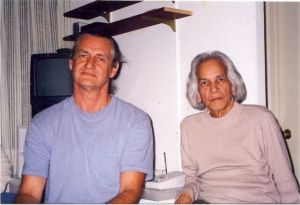Bandha is Bhakti | Mark Whitwell on Yoga as Devotion
Bandha is bhakti: devotion to Life; devotion to the real; devotion to Reality that some cultures call God.
Yoga was held in the great culture of Veda for thousands of years. In this culture, God, deity, guru, spouse, your body, and the whole cosmos on which it depends are all arising in the One Reality in which everything is happening.
So to practice Yoga as the whole body is devotion to the One, with the One, and all her forms. Yoga is a whole-body prayer to Life.
It is very relevant to the great Guru cultures of Christianity and Islam, as well as all other cultures whether religious or not.
Reality is power, wonder, grace, nurturing, intelligence, intrinsic harmony, and unspeakable beauty. The unitary movement of body, breath, and mind is the anciently given practical means to embrace reality/life as it actually is. It is not a pathway toward a future ideal but direct participation in the nurturing force that is life.
Participation in the union of inhalation with exhalation, the mutual sacrifice/giving of one to the other, which is the purpose of asana, is the embrace of reality as it is functioning as polar opposites in perfect union. Participation in the union of opposites in your own embodiment reveals the source of opposites known as the hridaya heart.
In the West, it can feel strange to think of asana and bandha as devotion because it is not known about in our society. Yet it is bhakti and soon it starts feeling very natural to our life.
The Three Bandhas
Anybody can have the advantage of breath and bandha in their lives without needing any cultural language or concepts around it.
In fact, the great sage U.G. Krishnamurti would say that Yoga arose because that’s what the body does in nature anyway. A traumatized body (and we have all been traumatized) will start moving and breathing in beautiful rhythmic patterns to release that trauma. And that’s what Yoga is.
But many people do have cultural language around the breath. Tirumalai Krishnamacharya (1888-1989), ‘the teacher of the teachers,’ would always say:
“When I inhale I receive God. Pausing after inhale I am with God. On an exhalation, I give myself to God. Pause after exhale I am given to God.”
In religious life, these pauses and retentions have a very honorable place in the practice. In the tantras of Hinduism and Buddhism, they have mysteries and religious purposes to these retentions. For a Hindu devotee, for example, Shiva-Shakti is there in the pause after inhale and you give them a moment to embrace.
Atheists Need Yoga
If we do not have a religious framework then things happen anyway. It is an experiential matter. The pause after the inhale is like an exclamation mark that affirms the purpose of the inhale. The purpose of the inhale is to receive. When you are inhaling you are receiving, receiving, receiving. And then at the pause at the top of the inhale you might say: “I am in the state of receptivity.”
The exhale is releasing, releasing, releasing. In the pause after exhale you can say: “I am in the state of release. I am released.” The retentions emphasize the state of the exhale or they are an emphatic exclamation mark at the end of the exhale.
Asana Creates Bandha
Bandha is not anything that is taught independent of asana itself. Accurately practiced, asana creates bandha. You can feel it arising in the practice when the principles are all there: in the retentions after inhale and after exhale. Retentions after exhale is muladhara and uddiyana bandha; retentions after inhale is jalandhara bandha.
For certain kinds of people, to get to that place of retention on exhale the muscularity is in and up. And then there is a pause and that is the bandha. You put a little bit of attention there; a little lifting. But you do not overemphasize it because then it becomes dangerous and people hurt themselves. They develop illness in their lower intestines. That is why I say to practice in a natural, non-obsessive way.
Unfortunately, Yoga has been taught so badly and even aggressively that anyone with sensitivity legitimately rejects it. This is sad because Yoga is the most important aspect of human life in the process of lifting off the social patterns of limit and the transition to our birthright of a free life in the natural state.
One day even the positive patterns of Yoga dissolve. We replace negative samskara (patterns) with positive yoga samskara until they all dissolve in the natural state. There is no telling when this all happens but it does. And we cannot bypass the process with gimmick techniques of meditation and liberation philosophies without practice.
Your Body Loves its Breath
Your body loves its breath and the inhale loves to exhale. It is a literal love relationship. The above to below principle of breath contains the natural life polarity of strength-receiving. Participation in this polarity reveals the source of both, the nurturing hridaya heart that is formed by the perfect giving and receiving of life. On inhale in jalandhara bandha the head softly gives over to its source, the hridaya. On exhale in uddiyana bandha and mula bandha the strength of bandha at the base is given over to the hridaya.
Bandha is bhakti, the practical action of surrendering to the heart.
* For more on the hridaya heart you can read the Hridaya Yoga Sutra.
Originally published here.
Author Bio


Comments
Post a Comment